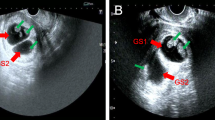Abstract
The frequency of twins resulting from a single embryo transfer has been reported to be 1.56%, with the majority being monochorionic. We present a case of septal rupture at 8 weeks of gestation and successful delivery at 36 weeks of gestation of a monozygotic dichorionic diamniotic twin after a single blastocyst transfer. This report could partially clarify the pathogenesis of monozygotic twins and septal disruption. A 37-year-old woman with 9 months of primary infertility was referred to our department. After seven cycles of artificial insemination, she underwent her first in vitro fertilization. Ten cumulous-oocyte complexes were retrieved, of which three were fertilized, and three blastocysts were cryopreserved. The first single blastocyst transfer in a hormone replacement cycle resulted in a dichorionic diamniotic twin pregnancy. Transvaginal ultrasound at 7 weeks and 4 days gestation revealed a size difference in the gestational sacs and a disruption of the inter-amniotic membrane between the two gestational sacs at 8 weeks and 6 days. Both fetuses were seen in the larger gestational sac; however, the umbilical cord of the migrated fetus was from the original gestational sac. Both fetuses developed without discordancy or obvious anomalies. At 36 weeks and 6 days of gestation, the patient underwent cesarean delivery, resulting in the birth of two viable male infants without any congenital anomalies (weighing 2256 g and 2456 g). Two amniotic cavities existed; however, no chorionic villi were present. There have been many reports on septal disruption in monochorionic diamniotic twins; however, only two cases of dichorionic diamniotic twins have been reported. Furthermore, the onsets in both reports were after the second trimester of pregnancy. This report presents the first case of septal disruption in dichorionic diamniotic twins during the first trimester.







Similar content being viewed by others
References
Japanese Society of Reproductive Medicine. Guidelines for the number of transplanted embryos to prevent multiple pregnancies 2007. http://www.jsrm.or.jp/guideline-statem/guideline_2007_01.html. Accessed 16 Jun 2023.
Japan Society of Obstetrics and Gynecology. ART data book. 2020. https://www.jsog.or.jp/activity/art/2020_ARTdata.pdf. Accessed 16 Jun 2023.
Ikemoto Y, et al. Prevalence and risk factors of zygotic splitting after 937 848 single embryo transfer cycles. Hum Reprod. 2018;33:1984–91. https://doi.org/10.1093/humrep/dey294.
Saito H, Tsutsumi O, Noda Y, Ibuki Y, Hiroi M. Do assisted reproductive technologies have effects on the demography of monozygotic twinning? Fertil Steril. 2000;74:178–9. https://doi.org/10.1016/s0015-0282(00)00557-4.
Li H, Shen T, Sun X. Monozygotic dichorionic-diamniotic pregnancies following single frozen-thawed blastocyst transfer: a retrospective case series. BMC Pregnancy Childbirth. 2020;20:768. https://doi.org/10.1186/s12884-020-03450-5
Chmait RH, Aghajanian P, Kontopoulos EV, Quintero RA. Prenatal diagnosis of spontaneous septostomy of the dividing membranes in complicated monochorionic diamniotic multiple gestations. J Ultrasound Med. 2009;28:663–8. https://doi.org/10.7863/jum.2009.28.5.663.
Jeanty C, Newman E, Jeanty P, Rodts-Palenik S. Prenatal diagnosis of spontaneous septostomy in dichorionic diamniotic twins and review of the literature. J Ultrasound Med. 2010;29:455–63. https://doi.org/10.7863/jum.2010.29.3.455.
Fleming T, Miller T. Spontaneous septostomy in monochorionic diamniotic twins resulting in cord entanglement and fetal demise. Australas J Ultrasound Med. 2012;15:103–6. https://doi.org/10.1002/j.2205-0140.2012.tb00014.x.
Dias T, Mahsud-Dornan S, Bhide A, Papageorghiou AT, Thilaganathan B. Cord entanglement and perinatal outcome in monoamniotic twin pregnancies. Ultrasound Obstet Gynecol. 2010;35:201–4. https://doi.org/10.1002/uog.7501.
Hall JG. Twinning. The Lancet. 2003;362:735–43. https://doi.org/10.1016/s0140-6736(03)14237-7.
Mio Y, Maeda K. Time-lapse cinematography of dynamic changes occurring during in vitro development of human embryos. Am J Obstet Gynecol. 2008;199(660):e661-660.e665. https://doi.org/10.1016/j.ajog.2008.07.023.
Behr B, Milki AA. Visualization of atypical hatching of a human blastocyst in vitro forming two identical embryos. Fertil Steril. 2003;80:1502–3. https://doi.org/10.1016/j.fertnstert.2003.07.001.
Shibuya Y, Kyono K. A successful birth of healthy monozygotic dichorionic diamniotic (DD) twins of the same gender following a single vitrified-warmed blastocyst transfer. J Assist Reprod Genet. 2012;29:255–7. https://doi.org/10.1007/s10815-011-9707-5.
Van Langendonckt A, Wyns C, Godin PA, Toussaint-Demylle D, Donnez J. Atypical hatching of a human blastocyst leading to monozygotic twinning: a case report. Fertility and Sterility. 2000;74:1047–50. https://doi.org/10.1016/s0015-0282(00)01554-5.
Busnelli A, et al. Risk factors for monozygotic twinning after in vitro fertilization: a systematic review and meta-analysis. Fertil Steril. 2019;111:302–17. https://doi.org/10.1016/j.fertnstert.2018.10.025.
Polin RA, Abman SH, Rowitch DH, Benitz WE, Fox WW. Fetal and neonatal physiology. 5th ed. Elsevier edn; 2017. pp. 101–113.
Gordon BJ, et al. Incidental septostomy after laser surgery for twin-twin transfusion syndrome: perinatal outcomes and antenatal management. Fetal Diagn Ther. 2018;44:285–90. https://doi.org/10.1159/000485034.
Author information
Authors and Affiliations
Corresponding author
Ethics declarations
Competing Interests
The authors declare no competing interests.
Additional information
Publisher's Note
Springer Nature remains neutral with regard to jurisdictional claims in published maps and institutional affiliations.
Data regarding any of the subjects in the study has not been previously published unless specified.
This is the first report on a case of septal disruption in dichorionic diamniotic twins during the first trimester.
Rights and permissions
Springer Nature or its licensor (e.g. a society or other partner) holds exclusive rights to this article under a publishing agreement with the author(s) or other rightsholder(s); author self-archiving of the accepted manuscript version of this article is solely governed by the terms of such publishing agreement and applicable law.
About this article
Cite this article
Nakamura, F., Takehara, I., Iizawa, S. et al. Septal Rupture During Early Pregnancy and Successful Delivery in Monozygotic Dichorionic Diamniotic Twin After a Single Blastocyst Transfer. Reprod. Sci. 31, 122–127 (2024). https://doi.org/10.1007/s43032-023-01340-7
Received:
Accepted:
Published:
Issue Date:
DOI: https://doi.org/10.1007/s43032-023-01340-7




